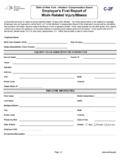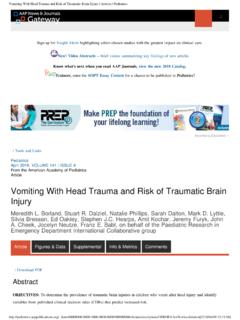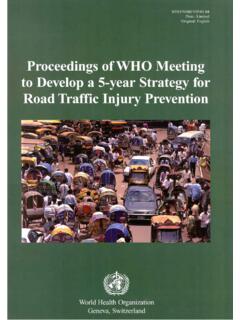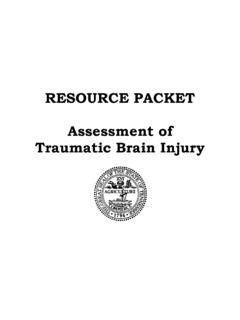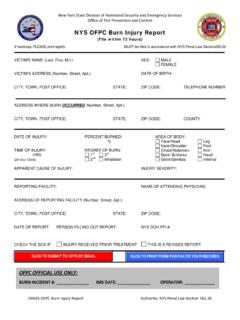Transcription of Antibiotic Prophylaxis for Penetrating Brain Injury
1 Antibiotic Prophylaxis for Penetrating Brain InjuryJ ;51:S34 RECOMMENDATIONSA. StandardsThe available data are not sufficient to support a treat-ment Standard for the role of prophylactic antibiotics afterpenetrating Brain Injury (PBI).B. GuidelinesThe available data are not sufficient to support a treat-ment Guideline for this OptionsUse of prophylactic broad-spectrum antibiotics is recom-mended for patients with OVERVIEWThe risk of intracranial infection among patients withPBI is high because of the presence of contaminated for-eign objects, skin, hair, and bone fragments driven into thebrain along the missile track. The presence of air sinuswounds or cerebrospinal fluid (CSF) fistulae may furtherincrease the risk of infection. Since sulfa drugs were in-troduced just prior to World War II, all published studieshave been of patients who received antibiotics after World War II, the only studies of the infection ratein PBI are those in which all patients received prophylacticantibiotics.
2 These data have been compared with prean-tibiotic series prior to World War II. Some conclusionsmay, in addition, be drawn from Class I and Class IIstudies that address the use of prophylactic antibiotics inclean elective neurosurgical procedures. Although the dataon clean cases do not apply directly to the PBI population,their analysis can justifiably support recommendations forPBI patients at the level of section of the Guidelines is directed exclusively atinfection Prophylaxis , meaning when antibiotics are begunearly after Injury before there is any evidence of clinicalinfection. The management of established infections ( ,wound infection, meningitis, or cerebral abscess) is not spe-cifically addressed PROCESSA MEDLINE search from January 1966 to January 2000,using the search termswounds,gunshot, andbrain injuriesorhead injuries, when limited to human subjects, identified 382articles.
3 Eighty-eight articles were rejected on the basis ofclearly irrelevant titles. An additional 33 articles were thenpulled from the bibliographies of reviewed articles. The pri-mary selection process, therefore, identified 327 articles forfurther review. Two independent reviewers read the abstractsof all 327 and selected 65 for further inclusion. Articles wererejected on the basis of relevance to the topic ( , pediatricpopulation, case reports, irrelevance to project, and series ofless than 10 subjects with no other unique reasons for inclu-sion). The 65 articles were then read in detail. During thisprocess, articles from the bibliographies of the 65 originallyselected articles were considered and rejected or added to theactive list using the above algorithm.
4 Of these 65 articles, 14were found appropriate and analyzed in detail for this sectionof the Guidelines. Because in these 14 articles, antibioticswere always given prophylactically, additional articles wereselected from the World War I era literature for additional articles were selected, using the same crite-ria as stated in the introduction of the Office of the SurgeonGeneral s World War II neurosurgical SCIENTIFIC FOUNDATIONH istoric ComparisonThe infection rate in the preantibiotic era duringWorld War I was reported by Whitaker to be War II, several articles compare the use of localsulfa powder alone and with the addition of penicillin,given either locally or systemically. The opportunity forthese studies was created by the delayed availability ofpenicillin to different theaters of war throughout the con-flict.
5 The reported infection rate with local application ofsulfa powder and/or parenteral sulfonamide therapy inthese studies was 21% to 31%. When penicillin was addedto this regimen in these studies, the clinical infection ratedropped to to 13%. A single report3challenges thisassertion. In Maltby s 200 patients, he states as far ascould be determined from the overseas records, no overalldifference in the drug therapy was apparent in the casesshowing infection. However, no statistics or case numbersare offered in this article to defend the position taken. Themost recent military and civilian series using a variety ofmore sophisticated Antibiotic regimens report clinical in-fection rates between 4% and 11%. The reported risk ofbrain abscess has dropped from in World War II to in more recent 6It is recognized that other factors, such as surgical andmanagement advances, may be responsible for these im-proved infection rates.
6 For example, in World War I emphasized closure of the ,8 During WorldWar II, this concept was extended to include a vigorousemphasis on dural closure. The World War II series, how-ever, provides a direct comparison of the results when theThe Journal ofTRAUMA Injury , Infection, and Critical CareS34 August Supplement 2001only significant variable among groups appears to be theaddition of penicillin. These data provide support for ourrecommendation to use RateThe rate of infection reported in series of patients withPBI varies directly with the use of broad-spectrum antibioticsearly in the management of these patients. It ranges from 1%to 59%, as seen in the reported infection rates in civilian andmilitary series in Table 1 that tracks the rate to the introduc-tion of antibiotics as used over the past six should be noted that in all these series subsequent to1945, the patients routinely received Antibiotic a study of data collected on 1,221 patients from theVietnam Head Injury Study, 37 cases of abscess were found(3%), 6 of which were incidentally discovered during post-mortem examinations of patients dying of unrelated retrospective study of 600 cases from the Lebanese conflictbetween 1981 and 1988 found intracranial infection in 30patients (5%).
7 Aarabi,11reporting on the final postsurgicaloutcome in 435 patients who sustained missile head woundsduring the Iran-Iraq War, report the presence of meningitis in25 of 71 patients who died from their injuries. A comparativestudy of bacteriologic contamination and infection rates be-tween primary and secondary exploration in 161 patients withmissile head wounds reports meningitis in six cases and thedevelopment of a cerebral abscess in two cases. Brandvold Levi et al.,20reporting on Penetrating cranial cere-bral injuries sustained during the Lebanese conflict, reportmeningitis in 8% of patients and the development of anabscess in 1%.The incidence of intracranial infection is lower (be-tween 1% and 5%) in series of patients with civilian et no deep intracranial infectionssuch as meningitis or abscess in a series of 120 civiliangunshot wounds to the head with penetration of the superficial wound infections were noted in the 54survivors from this series, all of whom received prophy-lactic antibiotics.
8 The reports in the civilian literaturecommonly report the development of Brain abscesses afterrare causes of Injury , such as pool or snooker cues,21,22pencils,23 26or a tree branch,27which may represent adifferent bacteriologic or fungal majority of intracranial infections after PBI occurwithin a relatively short period after Injury (55% within 3weeks; 90% within 6 weeks).28 However, in rarer instances,the development of a cerebral abscess may occur after manyyears, even 15 years after CultureRelatively few published studies30report on the re-sults of bacteriologic studies of removed fragments or onstudies of causative agents of infection in PBI. In Vietnam,Carey et that 45% of the fragments removedand cultured were positive, mainly with gram-positivebacteria.
9 Similarly, Hagan,32in a study of 506 patientswith Penetrating Brain wounds in the Vietnam War,showed isolation ofStaphylococcus epidermidisfrom re-moved fragments in two thirds of the patients, the othersshowing a variety of gram-positive and gram-negativeorganisms. Aarabi,10reporting on data from the Iran-IraqWar in 1983 to 1984, found positive cultures in approxi-mately 20% of samples, which included swabs from thescalp wound, Brain , and bone fragments. Cultures from thewound mainly demonstratedStaphylococcus,Acineto-bacte r,andStreptococcus. Cultures from removed bonefragments mainly demonstratedStaphylococcus,and cul-tures from removed Brain tissue grewStaphylococcus,Acinetobacter,Escheri chia coli,Klebsiella,andEnter-obacter.
10 A subsequent investigation of 105 patients withproven intracranial infections from the same conflictyielded positive cultures for gram-negative organisms in45% and gram-positive organisms in 15%.KlebsiellapneumoniaeandStaphylococcu s aureuswere the predom-inant , none of these authors describeresults of standardized anaerobic culture studies and do notTable 1 Rate of Infection with the Use of Broad-Spectrum AntibioticsEra and PopulationAuthors, YearDrugRate ofInfection (%) Brain Abscess(%)Preantibiotic; WWIM ilitaryWhitaker, ; WWIIM ilitarySlemon, 19459 Sulfa21 31 MilitarySlemon, : afterWWIIM ilitaryAarabi, 1998,41987,10199011; Rish etal., 19815; Taha et al., 19916 Broad-spectrum antibiotics4 et al., 199112; Byrnes et al.

